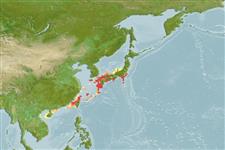Klassifizierung / Names
Namen | Synonyme | Catalog of Fishes(Gattung, Arten) | ITIS | CoL | WoRMS | Cloffa
>
Gobiiformes (Gobies) >
Gobiidae (Gobies) > Gobiinae
Etymology: Trimma: Greek, trimma, -atos = something crushed (Ref. 45335); kudoi: Named for Mr. Takahiro Kudo, who provided the holotype of the new species..
Environment: milieu / climate zone / depth range / distribution range
Ökologie
seewasser demersal; tiefenbereich 27 - 45 m (Ref. 75202). Temperate
Northwest Pacific: Japan.
Size / Gewicht / Alter
Maturity: Lm ? range ? - ? cm
Max length : 2.5 cm SL Männchen/unbestimmt; (Ref. 75202)
Kurzbeschreibung
Morphologie | Morphometrie
Rückenflossenstacheln (insgesamt): 7; Rückenflossenweichstrahlen (insgesamt): 9-10; Afterflossenstacheln 1; Afterflossenweichstrahlen: 9; Wirbelzahl: 26. This species differs from its congeners in the following combination of characters; scales on predorsal midline absent; elongate spines of first dorsal fin absent; 5th pelvic-fin ray unbranched, 50-70% of 4th ray in length; basal membrane between innermost pelvic-fin rays 10-17% of length of 5th ray; a shallow or deep interorbital trough, no postorbital trough; nape with a slightly developed longitudinal ridge in the midline; longitudinal scales 22-23; head ground color and body bright yellow, with iris vivid yellow, 3 deep purple oblique lines margined by pink when fresh (Ref. 75202).
Life cycle and mating behavior
Geschlechtsreife | Fortpflanzung | Ablaichen | Eier | Fecundity | Larven
Suzuki, T. and H. Senou, 2008. Two new species of the gobiid fish genus Trimma (Perciformes: Gobioidei) from Southern Japan. Bull. Natl. Mus. Nat. Sci. Ser. A. Suppl. 2:97-106. (Ref. 75202)
IUCN Rote Liste Status (Ref. 130435)
Bedrohung für Menschen
Harmless
Nutzung durch Menschen
Mehr Information
NamenSynonymeMetabolismusRäuberÖkotoxikologieFortpflanzungGeschlechtsreifeAblaichenSpawning aggregationFecundityEierEientwicklung
Alter/GrößeWachstumLänge-GewichtLänge-LängeLängenhäufigkeitenMorphometrieMorphologieLarvenLarven Pop.Dyn.RekrutierungDichteBRUVS
ReferenzenAquakulturAquakultur ProfilZuchtlinienGenetikElectrophoresesVererbbarkeitKrankheitenVerarbeitungNutrientsMass conversion
PartnerBilderStamps, Coins Misc.LauteCiguateraGeschwindigkeitSchwimmstilKiemenoberflächeOtolithsGehirngrößeSehfähigkeit
Tools
Zusatzinformationen
Download XML
Internet Quellen
Estimates based on models
Preferred temperature (Ref.
123201): 20.6 - 22.7, mean 22.1 °C (based on 5 cells).
Phylogenetic diversity index (Ref.
82804): PD
50 = 0.5000 [Uniqueness, from 0.5 = low to 2.0 = high].
Bayesian length-weight: a=0.01023 (0.00477 - 0.02194), b=3.02 (2.84 - 3.20), in cm total length, based on LWR estimates for this (Sub)family-body shape (Ref.
93245).
Widerstandsfähigkeit (Ref.
120179): hoch, Verdopplung der Population dauert weniger als 15 Monate. (Preliminary K or Fecundity.).
Fishing Vulnerability (Ref.
59153): Low vulnerability (10 of 100).
